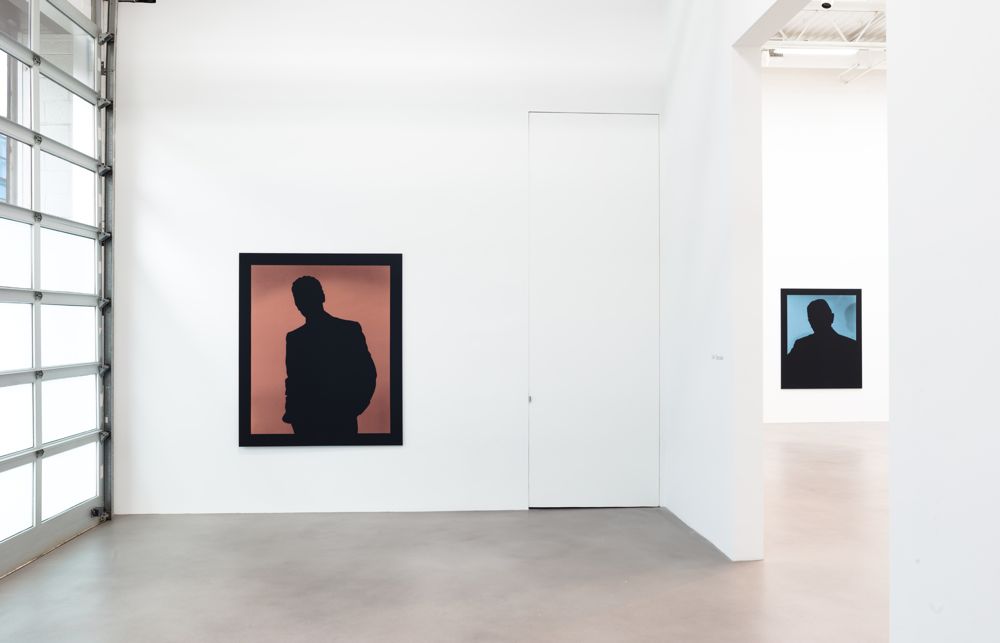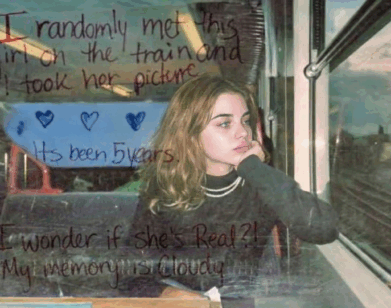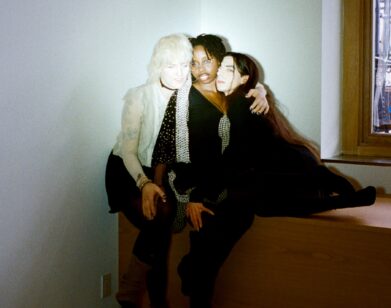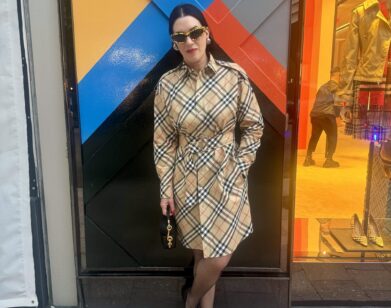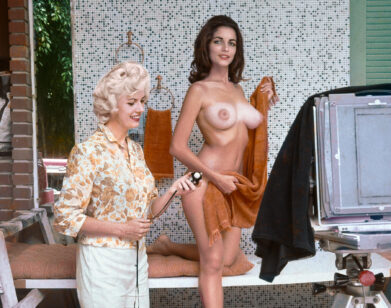John Stezaker’s Shadowed Land
British artist John Stezaker rose to prominence during the ’80s and ’90s with his small-scale photo collage manipulations. A film buff, Stezaker used 1940s and ’50s headshots and film stills from his vast personal collection to create highly charged yet fragmented compositions that question identity and origin. His mid-2000s “Marriage” series combined female and male headshots, providing a conceptual framework for classically imposed gender roles. For his latest exhibition, running at Petzel Gallery until November 9th, Stezaker has returned to large-scale canvases for the first time in over 25 years. These silkscreens and his larger video project Blind, both conceived from reappropriated stills, speak to our image-immersed present while still glorifying the mood and imagery of film noir and a rich cinematic past.
MERYN CHIMES: This is the first time you’ve done silkscreen in 25 years, what drew you back to it after all this time?
JOHN STEZAKER: The scale. I was sick of always showing in the viewing rooms of tiny galleries. I wanted to be in the big spaces, to be perfectly honest. And it was a challenge to me. I deeply felt I wanted that feeling of bodily relationship with the image and that kind of relationship with the figure that you get at that scale. I wanted to get back to that, and the only way I could think of doing it was through the method of silkscreen, which I’d used before. Having worked on a small scale and I suppose becoming known for my small scale work, I was always very defensive about it because people would say, “Why don’t you do these bigger alternatives.” There’s a lot of commercial pressure to do these bigger works at a certain point. I was repeatedly resistant and defensive of the small-scale work, and it became more of an ideology. The last cinematic silkscreen I did was in 1989. I used to do it myself but then I hurt my back and stopped doing it. And it’s interesting because this show is just an attempt to resume at this point.
CHIMES: Talking about inspiration in terms of the scale of these pieces. Andy Warhol also dealt with both large-scale silk screens and the cinematic. Do you see him as an inspiration?
STEZAKER: Yes, totally. That’s where it started. That’s why I moved into silkscreen in the first place—because of Warhol. Warhol in the late ’60s when I was at college and first saw Warhol’s silkscreens and tried to read everything about him. I was just fascinated. I wanted to go into that territory because of it. I don’t know quite what the relationship is between silkscreens and cinema.
CHIMES: Beyond Warhol, did you have any other influences when turning back to this larger format?
STEZAKER: A lot of things, really. It’s very difficult to know where to start. In some ways you could start with the origins of painting itself. But that could be about cinema too, as cinema is a projection of shadows. You think of it as a projection of light but actually it’s shadow—always. I had this idea that was relating cinema and painting to this projection of shadow. There’s an interesting ambiguity about it, and I think that ambiguity in central to the cinema tradition. Most silhouettes are used to remember the dead. Interestingly, I did a series in 1979 very like this on small-scale in which I cut the figures out.
CHIMES: Your earlier “Dark Star” works.
STEZAKER: Yes, “Dark Star.” My mother has one of those and the reason I gave it to her was she said that it reminded her of my father. At the time I gave it to her, he was alive. But he died within a year or two of that. Now she keeps it on the wall as a way of remembering him. It’s actually someone else entirely; it’s a film actor. But, it’s very interesting how silhouettes work. You can project what you like into them in some ways.
CHIMES: Speaking of the “Dark Star” works, I wanted to touch on their relationship to the “Shadow” pieces. When I look at these works they also seem to deal with anonymity. How would you compare these images to your “Dark Star” works?
STEZAKER: I think it’s a simple resumption. I don’t know why I keep going over the same territory, that’s a mystery to me, why I keep doing this. At this point I think the relationship is between absent and present. Between the presence and the absence of the being.
CHIMES: So these new works aren’t really about absence, it’s more about what you can read into it?
STEZAKER: You can project what you like into a silhouette. [That’s] why they’re so powerful—much more powerful than a photograph of a loved one who is no longer with us. [A photograph] is too particular and it tends to replace the memory you have of them, but the silhouette allows you to search in it for your remembrance of that person.
CHIMES: In terms of using film stills from the ’40s and ’50s and film noir, is that something that you grew up with or were interested in the beginning of your artistic practice?
STEZAKER: Even earlier, actually. I think it starts with not being allowed to go to the cinema as a teenager by my parents. By the time I was about 12 or 13, I think I’d only seen two or three films.
CHIMES: Which films?
STEZAKER: Well the first one, the very first one was Snow White. I remember seeing Ben Hur. Essentially my relationship with cinema was the line of film stills you saw on the outside of the theater, which, of course, I’ve been collecting ever since. I became more and more interested in this sort of shadowy underworld that’s now called film noir, in those days it was just B-movies. When I eventually did get to see these things they weren’t half as interesting as the still images seemed to imply. It was the shadows that always interested me.
CHIMES: I read that you don’t like to use film stills that are very valuable or that people covet or recognize. Why is that?
STEZAKER: It’s partly to absolve my conscious. Whenever I approach a commercial collection I say, “Do you have any damaged or unwanted material?” After a while I began to realize it was actually the most valuable material because I preferred them to be anonymous actors. Damaged I also enjoyed very much—damage is part of what I do to the work anyways. If it’s already damaged somehow I feel I’m vindicated in cutting it. Even the actual aesthetic effect of damage can be an inspiration for the piece on all sorts of levels.
CHIMES: Blind feels a bit like Rothko—like a color field—in that it’s an environment you enter into.
STEZAKER: My wife said, “This is John being Abstract Expressionist.”[laughs] My wife is very aware of my work as something to do with control and distance and a kind of very cool sensation, so when she saw this she thought this is me being completely the opposite of my normal character. My work is about stilling and creating a contemplative, silent relationship with something that usually speaks and is legible—a confrontation with obscurity as opposed to transparency. I felt I needed to explore that violent, incessant relationship with the image that cinema imposes. In some ways, you can see my collage work as a sort of redemption of the cinematic image, because in cinema you are blind to the image in a way. The image is constantly transforming; you can only follow it, you can’t see it. My work has always been about making you see what you don’t normally see, the other side of the incessant succession.
CHIMES: Do you think that this incessant succession is a commentary or at least representative of our current visual environment?
STEZAKER: Yes, I think it is. That’s why I did it. It’s this overload I sense in the contemporary world. In a way, this is like a film of all films isn’t it? You could carry on throughout my entire collection couldn’t you? [Blind] happens to be only 2,000 [frames]. But I probably have about 100 times that in my collection.
CHIMES: Every frame plays for 1/24 of a second, this means you can never have the same experience twice, right?
STEZAKER: That’s right, no two people ever see the same film. And when you see it on specific occasions, you never see the same film. I’ve had people sit for two hours watching this in order to try and master it, to see every single image. But, physiologically, out of the 24 frames in a second you probably register one or two.
CHIMES: How did you select the images for Blind, from you vast collection?
STEZAKER: It reflects on what you just said about what one sees. I wanted to take anything out with labels and words, and I took all the color out—I thought it should be black and white. It happens that the person who was making my film with me, English was not her first language and she picked up the wrong box. When it came back, I just thought, “It’s amazing.” It’s much better than the box I was going to use. So, this is exactly as it came from the archives, quite arbitrarily. I wouldn’t say randomly, but arbitrarily. That really surprised me. I was expecting it to be violent and incessant and sort of disturbingly too much to take, but what I didn’t expect was what an indelible sense the image starts to create after you look at it for a while. After you get absorbed into it you seem to enter into an altered state in relationship to the image. The image is powerful; rather than being annulled or annihilated by succession, it seems somehow to become indelible.
CHIMES: Do you see this an evolution beyond your previous collage and silkscreen work?
STEZAKER: We talked earlier about Warhol and the relationship between film and silkscreen and I always fanatisized when I was making my silk screens back in the ’70s or ’80s of making films. At the time I was represented in London by a gallery called the Nigel Green Gallery who also represented Warhol, and Warhol was constantly sending him silkscreens on canvas in order to raise money for the next movie. I always fanatisized that I would use my silkscreens as a way of making a movie. But I haven’t exactly thought what kind of movie yet.
CHIMES: So you’re interested in moving beyond video pieces to an actual film?
STEZAKER: That’s the next stage.
JOHN STEZAKER’S EXHIBITION OF NEW SILK SCREENS IS ON VIEW AT PETZEL GALLERY IN NEW YORK THROUGH NOVEMBER 9.

